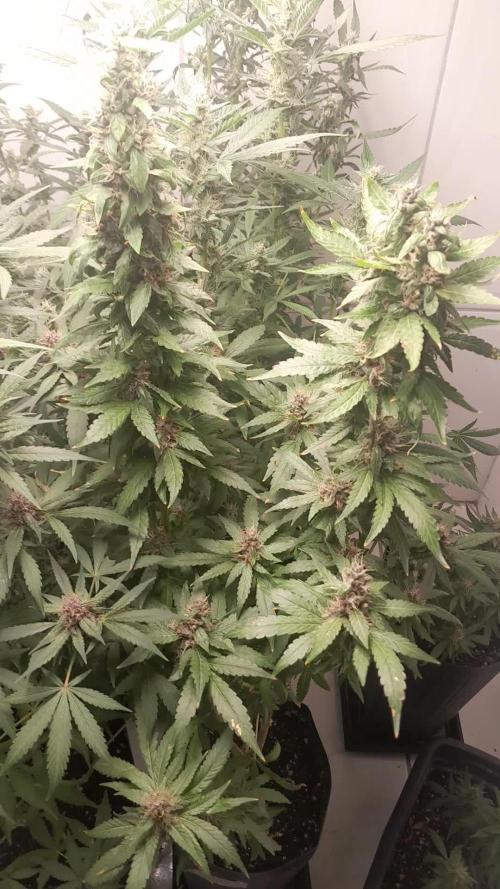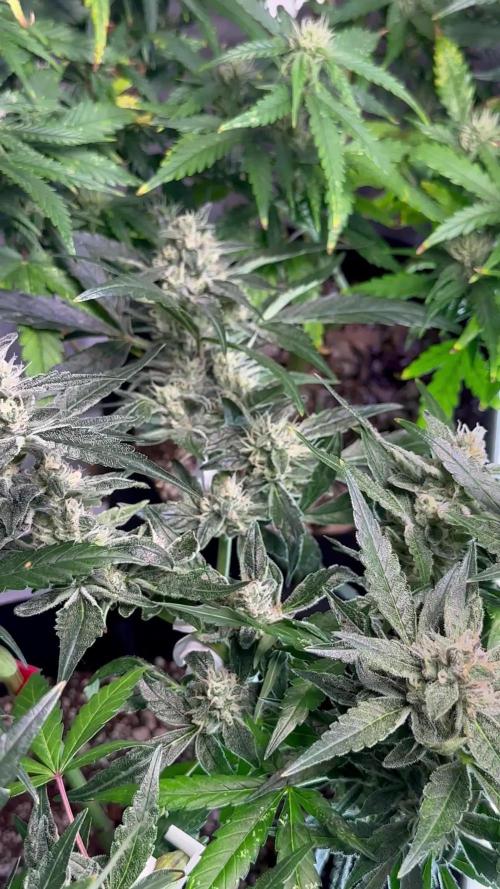The Grow Awards 2026 🏆 































Processing
Likes
Comments
Share


@Mickeymouse
Follow
Tento týden jsem kytky trochu přehnojil, jinak roustou moc hezky, těším se na přepnutí
Likes
107
Share


@Tropicannibis_Todd
Follow
💩Holy Crap Growmies We Are Back💩
Entire grow has been stunted by the soil/medium
Code Name FBT2309
Well growmies we are at 49 days in and everything is going as good as possible 👌
👉 Well folks shes been a busy girl , making a ton of bud , just hope she chunks up 👌
Lights being readjusted and chart updated .........👍rain water to be used entire growth👈
👉I used NutriNPK for nutrients for my grows and welcome anyone to give them a try .👈
👉 www.nutrinpk.com 👈
NutriNPK Cal MAG 14-0-14
NutriNPK Grow 28-14-14
NutriNPK Bloom 8-20-30
NutriNPK Bloom Booster 0-52-34
I GOT MULTIPLE DIARIES ON THE GO 😱 please check them out 😎
👉THANKS FOR TAKING THE TIME TO GO OVER MY DIARIES 👈
Likes
15
Share


@the_big_pink_place
Follow
Everything's going good sorry for the delay been busy , this week started on march 2/22. Will be posting trichome pictures.
Likes
37
Share


@Roberts
Follow
Mandarin XL autoflower is finally starting to shoot pistils. She is overdue on a solution change. Everything is going good and I will get to a change this weekend. Nothing else to report at the moment. Thank you Gen1:11, Medic Grow, and Ganja Farmer. 🤜🏻🤛🏻🌱🌱🌱
Thank you grow diaries community for the 👇likes👇, follows, comments, and subscriptions on my YouTube channel👇. ❄️🌱🍻
Happy Growing 🌱🌱🌱
https://youtube.com/channel/UCAhN7yRzWLpcaRHhMIQ7X4g
Likes
55
Share


@valiotoro
Follow
Week 13!🤓
I get the fever every time you cross my mind😳
2 weeks now that she s under the FC1000 EVO @ 100% without any sign of foxtail,nanners or light stress!!!without CO2 or Exhale bags or idk what…it’s a beast🤩
I don’t have a PPFD meter or the app on my phone but it should be around 1000-1400 umol/m2!LOL
I don’t have any secret ingredient the key is to have a good ventilation and a super healthy plant!
Don’t do that if your plant is not healthy or she will burn for sure!🤓
Take care💚
Processing
Likes
23
Share


@MadeInGermany
Follow
COMMENTED BY
MadeInGermany MadeInGermany 5 minutes ago
Hey everyone 🤗.
There isn't much to report this week.
It was topped again, otherwise everything is like last week.
She is developing well 👍.
I wish you lots of fun with the update, stay healthy and let it grow 🌱🍀
You can buy this Strain at
https://thecaliconnection.com/seeds/girls-scout-cookies-34.html
You can buy the fertilizer at
https://www.greenbuzzliquids.com/
Type:
Girls Scout Cookies
☝️🏼
Genetics:
GSC Tint Mint
👍
Vega lamp:
2 x Todogrow Led
Quantum Board 100 W
💡
Bloom Lamp :
2 x Todogrow Led
Cxb 3590 COB 3500 K 205W
💡💡☝️🏼
Soil :
Canna Coco Professional +
☝️🏼
Fertilizer:
Green Buzz Liquids :
Organic Grow Liquid
Organic Bloom Liquid
Organic more PK
More Roots
Fast Buds
Humic Acid Plus
Growzyme Big Fruits
Clean Fruits
Cal / Mag
Organic Ph - Pulver
☝️🏼🌱
Water:
Osmosis water mixed with normal water (24 hours stale that the chlorine evaporates) to 0.2 - 0.4 EC. Add Cal / Mag 2 ml per l water every 2 waterings . Ph with Organic Ph - Pulver to 5.8 .
Likes
44
Share


@ElRojo
Follow
I made some begginers mistakes in week 4 but this lady Is strong and bounced back
3/02/21 i snapped a big fan leaf :((
Processing
Likes
15
Share


@CanadianFillmore
Follow
Flushing begins for the Og kush and blueberry. All three plants are incredibly sticky, stanky, dense and heavy! The OG Kush plants are blowing my mind, I'm amazed at how much they have fattened up the last week.
The super lemon haze starts week 7 and is also sticky and stanky, she's also starting to pack on weight and density.
Likes
13
Share


@Robeeriegenetics
Follow
Replacement seeds not fairing well lol but chosen mothers are thriving
Likes
6
Share


@Anonymus420
Follow
Awesome ! Big hard and jucy headbud 🙌 the smell is very delicus !!
I don’t know the genetic about this plant ‘cause i found it in some weed gifted to me but it’s incredible only 73 day from germination it ready to harvest 💪🏻💪🏻💪🏻🌲
Likes
11
Share


@CocoLogic
Follow
Sept 6th: (F20)
Fertigation once a day with same recipe (1200 EC 6.1 PH) watered until 10-20% run-off
Sept 7th: (F21)
Fertigation once a day with same recipe (1200 EC 6.1 PH) watered until 10-20% run-off
Sept 8th: (F22)
Fertigation once a day with same recipe (1200 EC 6.1 PH) watered until 10-20% run-off
Sept 9th: (F23)
Fertigation once a day with same recipe (1200 EC 6.1 PH) watered until 10-20% run-off
Sept 10th: (F24)
Fertigation once a day with same recipe (1200 EC 6.1 PH) watered until 10-20% run-off
Had to supercrop 1 branch on the PE#2 since it was almost in the roof of the tent
Sept 11th: (F25)
Fertigation once a day with same recipe (1200 EC 6.1 PH) watered until 10-20% run-off
Sept 12th: (F26)
Fertigation once a day with same recipe (1200 EC 6.1 PH) watered until 10-20% run-off
Note: The PE#2 had a late stretch this week oO hope she is done stretching, dont got more height for it! Had to supercrop one branch on it this week since it was almost in the tent roof.
Its funny that the TUT who is 60-65 Flower days is way in advance in bud forming on the PE#2 who is supposed to be 45-50 flowering days
Likes
8
Share


@Sorelone
Follow
Entlaubt und LsT bei 2 von 3 Ladys , Netz eingebracht nächste Woche Blüte beginnen
Likes
10
Share


@mr_smooke
Follow
Here we are on day 28.
On day 23 i spoted Spider Mites. Next day i been spray leavs whit neem oil, for now SM are gone i hope they will not come back. She coming along nicely😁🤩🤘✌️
Likes
40
Share


@Ukfarmer420
Follow
Hi guys
lost track of where i am now lol so we will run until there done lol I got a seprate dry tent now so makes my life easier.
1 purple startdawg lst
1 green startsawg lst
1 cheese lst
1 cheese oh natraul grown with polyploid
2 x pot noodle blueberry
1 x blueberry lst
3 x baby photo period big budha cheese.
Leave me a comment let me know your thoughts so far.
Likes
7
Share


@Growing_Spartan
Follow
I finally started flowering the crescendo rbx1 and I’ve got to say, she looks great! Green stems and leaves. She fills out this 5x5 pretty well and I’m happy with it.
Plucked a couple leaves that blocked prime bud sites and weaved her long arms outwards to fill up my tent and get more light penetration.
Likes
6
Share


@Jardineiro_Br
Follow
Segue com belos botões se desenvolvendo achonque vai ser bem produtiva essa planta , ela foi selecionada entre 10 plantas germinadas para esse diário e parece que deu certo .























